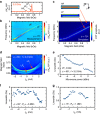Spin caloritronic nano-oscillator
- PMID: 28744017
- PMCID: PMC5527023
- DOI: 10.1038/s41467-017-00184-5
Spin caloritronic nano-oscillator
Abstract
Energy loss due to ohmic heating is a major bottleneck limiting down-scaling and speed of nano-electronic devices, and harvesting ohmic heat for signal processing is a major challenge in modern electronics. Here, we demonstrate that thermal gradients arising from ohmic heating can be utilized for excitation of coherent auto-oscillations of magnetization and for generation of tunable microwave signals. The heat-driven dynamics is observed in Y3Fe5O12/Pt bilayer nanowires where ohmic heating of the Pt layer results in injection of pure spin current into the Y3Fe5O12 layer. This leads to excitation of auto-oscillations of the Y3Fe5O12 magnetization and generation of coherent microwave radiation. Our work paves the way towards spin caloritronic devices for microwave and magnonic applications.Harvesting ohmic heat for signal processing is one of major challenges in modern electronics and spin caloritronics, but not yet well accomplished. Here the authors demonstrate a spin torque oscillator device driven by pure spin current arising from thermal gradient across an Y3Fe5O12/Pt interface.
Conflict of interest statement
The authors declare no competing financial interests.
Figures




References
-
- Flipse J, Dejene FK, van Wees BJ. Comparison between thermal and current driven spin-transfer torque in nanopillar metallic spin valves. Phys. Rev. B. 2014;90:104411. doi: 10.1103/PhysRevB.90.104411. - DOI
-
- Choi G-M, Moon C-H, Min B-C, Lee K-J, Cahill DG. Thermal spin-transfer torque driven by the spin-dependent Seebeck effect in metallic spin-valves. Nat. Phys. 2015;11:576–581. doi: 10.1038/nphys3355. - DOI
Publication types
LinkOut - more resources
Full Text Sources
Other Literature Sources

